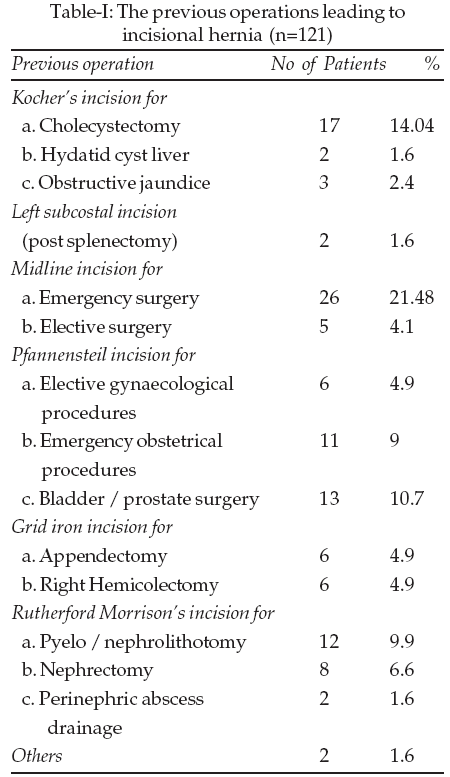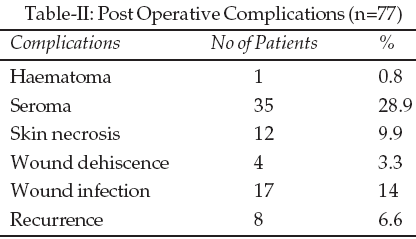|
|
||||
|
Published by : PROFESSIONAL MEDICAL PUBLICATIONS |
||||
|
ISSN 1681-715X |
||||
|
||||
|
- |
||||
|
ORIGINAL ARTICLE |
||||
|
- |
||||
|
Volume 24 |
April - June 2008 (Part-I) |
Number 2 |
||
|
|
||||
|
|
||||
|
|
||||
|
Published by : PROFESSIONAL MEDICAL PUBLICATIONS |
||||
|
ISSN 1681-715X |
||||
|
||||
|
- |
||||
|
ORIGINAL ARTICLE |
||||
|
- |
||||
|
Volume 24 |
April - June 2008 (Part-I) |
Number 2 |
||
|
|
||||
|
|
||||
Out come of mesh repair for incisional hernia
Mohammad Zarin1, Muhammad Rafiq Afridi2,
Tariq Saeed3,
Rooh-ul-Muqim4, Mahmud Aurangzeb5, Mohammad Aziz Wazir6
ABSTRACT
Objective: To determine the results of incisional hernia repair with prosthetic mesh.
Methodology: It is a retrospective descriptive study, conducted at Surgical "D" ward Khyber Teaching Hospital, Peshawar from January, 2002 to October, 2006. A total of 121 patients were included in this study. Those patients with incisional hernia, who were repaired with mesh and completed the minimum of 9 months of follow up, were included. Patients who were clinically diagnosed to have incisional hernia were admitted and after necessary preparation, were operated and defect in the abdominal wall was closed by a synthetic mesh. During the early post operative and follow up period, patients were looked for complications like seroma, infection, chronic discharging sinus formation and recurrence.
Results: Out of 121 patients, 73 were female and 48 were male. In most of the patients the incisional hernia resulted from emergency procedures. In 35 (28.9%) patients, there was post operative seroma formation, 17 (14%) patients had wound infection. one (0.8%) patient developed subcutaneous heamatoma due to unidentified bleeding which later on required evacuation under general anesthesia. Eight (6.6%) developed recurrence of hernia out of which some patients were treated by repeat Mesh repair. In 12 (9.9%) patients there was mild to moderate skin margin necrosis and in these cases debridement was a proof of successful treatment. Partial wound dehiscence was found in 3.3% of patients.
Conclusions: Incisional hernia is more common in midline laparotomy wounds specially performed in emergency conditions and onlay mesh repair procedure has high acceptable outcomes.
KEY WORDS: Incisional hernia, Mesh repair, Seroma.
Pak J Med Sci April - June 2008 (Part-I) Vol. 24 No. 2 213-216
1. Dr.
Mohammad Zarin FCPS, MRCS
Senior Registrar
2. Dr. Muhammad Rafiq Afridi MBBS
Trainee Medical Officer
3. Dr. Tariq Saeed FCPS
Senior Registrar Surgical ICU,
4. Dr. Rooh-ul-Muqim FCPS
Assistant Professor,
5. Dr. Mahmud Aurangzeb FRCS
Associate Professor,
6. Dr. Mohammad Aziz Wazir FRCS
Professor & head of Department, Surgical - D Ward,
1-6. Khyber Teaching Hospital,
Peshawar - Pakistan.
Correspondence:
Dr. Mohammad Zarin,
House, 123, Street 07, E1, Phase 1,Hayatabad, Peshawar
Email: drmzareen@yahoo.co.uk
* Received for Publication: July 7, 2007
* Revision Received: February 15, 2008
* Revision Accepted: February 20, 2008
INTRODUCTION
Extrusion of peritoneum and abdominal contents through a weak operative scar or accidental wound on the abdominal wall is called an incisional hernia. It is one of the most important complication of abdominal surgery specially performed for emergency conditions. The overall incidence of incisional hernia is 3-5% and is more common in females.
1,2 The predisposing factors for incisional hernia are advanced age, immunocompromised state (renal failure, steroid use, diabetes), obesity, malignancy, abdominal distension from obstruction or ascites, poor technical closure, post operative wound haematoma, wound infection, atelectasis and chest infection.3 Some patients undergoing, operation have a very high chance of wound haematoma and infection, dehiscence and recurrence.4 Different procedures are available for the repair of these hernias, including the anatomical repair, Mayo’s, Keel’s and Cattle’s repair but mesh repair is the gold standard for incisional hernia.9 Recurrence is more common in larger incisional hernias after repair. One third of hernias will recur within three years.PATIENTS AND METHODS
A total of 121 patients were included in this study who underwent mesh repair of incisional hernias in surgical "D" ward Khyber Teaching Hospital, Peshawar from January 2002 to January 2006. However the study was continued till October 2006 to complete the nine month follow up.
Inclusion criteria: All patients who were previously operated for one or other reason and developed incisional hernia were included in this study.
Exclusion criteria: Patients of incisional hernia with comorbid disease like cirrhosis, intra-abdominal malignancy or chronic obstructive pulmonary disease (COPD) were excluded from the study.
All patients were admitted from outdoor patient department as elective cases, were thoroughly investigated and looked for any contraindication of surgical intervention. Pre-operatively rough assessment of the size of abdominal wall defect was done and hernial size was measured in at least two dimensions. Prophylactic antibiotic was given on the morning of surgery. Patients were operated and mesh repair was done irrespective of the size and site of incisional hernia. In all cases fascial closure was done first and then an onlay mesh repair was done using prolene mesh (size 30x30cm or 15x15cm) depending upon the size of the fascial defect. Vacuum drains were put in parietes and patients were shifted to ward. Early mobilization was encouraged in all cases and Deep Venous Thrombosis (DVT) prophylaxis was done in most of the cases. Drains were removed after they remained dry for more than 24 hours. Patients were discharged and asked to visit the outpatient department at 2-3 monthly intervals for a minimum of nine months and during these visits, they were looked for any evidence of complications like seroma, stitch sinus formation, mesh sepsis, intestinal obstruction and recurrence. Findings were recorded on a proforma and at the end of the study, the results were compiled and different variables were noted and data analysis was done.
RESULTS
One hundred twenty one (73 female and 48 Male) patients were included in this study. In majority of the patients, there were previous history of laparotomy through midline incision for emergency condition, like peritonitis, intestinal obstruction, gunshot injury, intra abdominal abscess etc. while in 22 cases, the hernia occurred in Kocher’s incision made for cholecystectomy, hydatid liver disease and obstructive jaundice. (Table-I)

The most common post operative complication was seroma formation and majority of these patients were treated by single or repeated aspirations. (Table-II) This complication was followed by wound infection ranging from superficial wound infection to frank prosthesis sepsis. Most of such patients were treated by conservative measures like repeated dressings and debridement and antibiotics. Only one patient needed removal of Mesh as she developed enterocutaneous fistula. The recurrence rate was 6.6% and five of these patients were treated by repeat Mesh repair but the remaining three patients were lost to follow up. In one patient an unidentified bleeder led to subcutaneous heamatoma formation which was evacuated. Twelve (9.9%) patients developed different degrees of skin margin necrosis. Majority of these patients did well by simple debridement while few patients needed resuturing. Wound dehiscence was also noted in four patients due to infection.

DISCUSSION
Incisional hernia starts as asymptomatic partial disruption of the deeper layers of abdominal wound during the immediate or early post operative period.
7 Sepsis is the main culprit for causation of incisional hernia.8-12 In our series midline incisions were more commonly involved and similar findings are also noted by other researchers.3,12 Several procedures with simple repair and mesh repair have been proposed, but controversy still exists in literature about the effectives of mesh repair versus simple anatomical closure.13 Some authors argue that results of mesh repair are superior to simple repair at it has less recurrence rate14 while some authors have reported favorable results with mesh repair. They include combination of mesh and fascia, sandwich of mesh and rectus sheath and a complex mesh peritoneal sandwich, but the overlapping technique using combined fascia and mesh produce better results.15-17 Seroma formation was the most common complication followed by wound infection in our study and these results are comparable to some studies but our values are bit higher as compared to other studies.15,18,19Onlay mesh repair technique was used in all of our patients. In our study, various degree of wound infection ranging from superficial infection, mesh sepsis and abscess formation was noted in 17 (14%) patients and majority of these patients were treated by conservative measure. Only one patient was treated by removal of the Mesh. We noticed a recurrence of hernia in eight (6.6%) patients in our series and similar results have been shown in other national and international studies.
20,21CONCLUSIONS
Incisional hernia is more common in midline laparotomy wounds specially performed for emergency conditions and onlay mesh repair procedure has high acceptable outcomes.
ACKNOWLEDGMENT
We are thankful to Mr. Gohar Said for secretarial help and assistance in the preparation of the manuscript.
REFERENCES
1. Ikram MS. Incisional Hernia: A study of aetiological factors. Pak J Surg 1995; 11(3):146-8.
2. Luijeidik RW. A comparison of suture repair with mesh repair for incisional Hernia. New Eng J Med 2000;343(6):392-8.
3. Cuschieri A, Steele RJC, Moossa AR, eds. Incisional Hernia. In Essential Surgical Practice, 4th ed. New York: Arnold publications 2002;169.
4. Khaira HS, Lall P, Hunter B, Brown JH. Repair of incisional hernias. J R Coll Surg Ed 2001;46:39-43.
5. Luijendijk RW, Hop WC, Van den Tol MP. A comparison of suture repair with Mesh repair for incisional hernia. N Eng J Med 2000;343:392-8.
6. Shaikh NA. Comparative study of repair of incisional Hernia. Pak J Surg 1993; 9;102-8.
7. Russell RCG, Williams NS, Bulstrode CJK, eds. Incisional Hernia. In: Bailey & Love’s Short Practice of Surgery, 4th ed. London: Arnold 2004;291.
8. Ellis BT. Abdominal Wound Closure- Comparison of Monofilament Nylon & Polyglycolic acid. Surg 1981;89:672-77.
9. Greenall PAV, Evans MJ. Single layer mass closure of Major laparotomies by continuous suturing. J Roy Soc Med 1979;72:889-93.
10. Jones TE, Newell ET, Brabaker RE. The use of the Alloy Steel wire in closure of abdominal wounds. Surg Gynaecol Obstet 1941;72:1056-9.
11. Irvin TT, Stoddard CJ, Greancy MC. Abdominal wound healing. A prospective clinical study. Br Med J Clin Res 1977;2:351-2.
12. Greenburg AG, Said RP. Peskirs GW. Wound dehiscence. Pathophysiology and prevention. Arch Surg 1979;114:143-6.
13. Loh A, Rajkumar JS, South LM. Anatomical repair of large incisional hernia. Ann R Coll Surg Engl 1992;74:100-05.
14. Liakakos T, Karanikas I, Panagiotidis H, Dendrinos S. Use of marlex mesh in the repair of recurrent incisional hernia. Br J Surg 1994;81;248-9.
15. Usher FC. New technique for repair of incisional hernias, with marlex mesh. Am J Surg 1979;138:740-1.
16. Browse NL, Hurst P. Repair of long, large midline incisional hernias using reflected flaps of anterior rectus sheath, reinforced with marlex mesh. Am J Surg 1979;138-9.
17. Whitley MS, Chaudhuri RB. Combined fascia and mesh closure of large incisional hernias. J R Coll Surg Edinb 1998;43:29-30.
18. Molley GR, Moran KT, Waldron RP, Kirwan WO. Massive incisional hernia; abdominal wall replacement with Marlex mesh. Br J Surg 1991;78:242-4.
19. Lewish RT. Knitted polypropylene (Marlex) mesh in the repair of incisional hernia. Can J Surg 1984;27:155-57.
20. Rehman A, Nawaz A, Amanullah A, Mukhtiar Ali. Recent trends in the management of incisional hernia. J Portgrad Med Inst 2006;20:292-96.
21. Javid S. Incisional hernia-10 years expereicne. Pak J Surg 2006;22(3):146-49.
HOME | SEARCH | CURRENT ISSUE | PAST ISSUES
Professional
Medical Publications
Room No. 522, 5th Floor, Panorama Centre
Building No. 2, P.O. Box 8766, Saddar, Karachi - Pakistan.
Phones : 5688791, 5689285 Fax : 5689860
pjms@pjms.com.pk